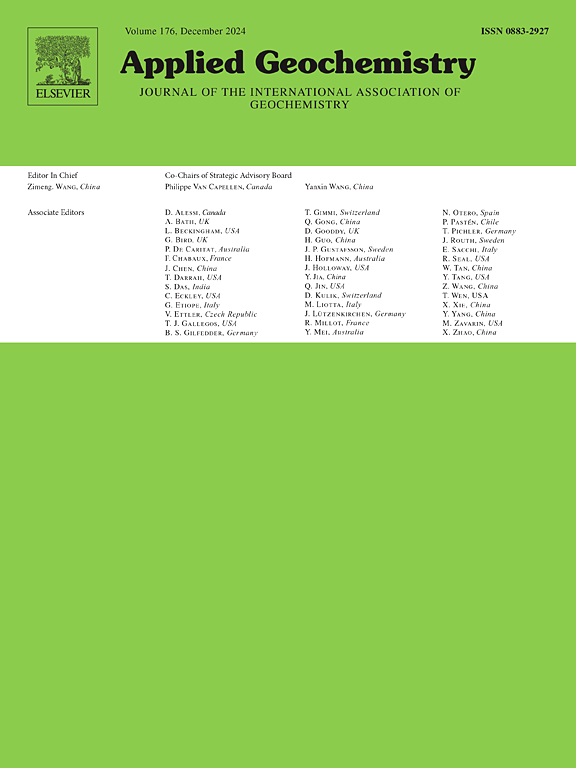Regional geochemical survey of Canadian Arctic sediments: insights into provenance, sediment dynamics and trace metal enrichment
IF 3.4
3区 地球科学
Q1 GEOCHEMISTRY & GEOPHYSICS
引用次数: 0
Abstract
Major and trace element contents, grain size distribution and total organic carbon contents were measured in 141 marine surface and terrestrial sediment samples to study modern sediment dynamics in the Canadian Arctic (CA) and to provide an assessment of metal enrichment for V, Zn, Mn and Fe. Samples were collected from different areas between Baffin Bay and the Beaufort Sea during the ArcticNet 2016–2022 expeditions onboard the Canadian Coast Guard icebreaker Amundsen. Geochemical data combined with multivariate statistical analyses allowed the division of the CA into three chemical clusters (CC) and four regional provinces. Central CA (CC#1) and southeastern CA (CC#2) are mainly composed of relatively coarse sediments rich in detrital carbonates (Ca, Mg) and siliciclastic elements (Si, K, Zr), respectively, reflecting coastal erosion of surrounding land (e.g., Victoria Island, Baffin Island) and transport of sediment-laden sea ice. The sediments of CC#3, comprising western and eastern CA, are characterized by organic carbon and Fe–Mn oxyhydroxides. Western CA, which is also characterized by fine-grained aluminosilicates, is influenced by the Mackenzie River discharge, while eastern CA is shaped by polynyas and glacial erosion. The highest concentrations of V and Zn are recorded in the western CA. Over the whole region, significant positive correlations of Al with Zn, V and Fe suggest that lithogenic-derived inputs influence the distribution of these metals in sediments from the CA and that Fe oxides represent the main carrier phase. In western CA, Mn displays positive but weaker relationships with Al and Fe, suggesting a mixed source of Mn oxyhydroxides linked to both detrital fractions and authigenic processes near the sediment-water interface. High terrestrial Mn oxyhydroxide inputs from the Mackenzie River are remobilized and transported to areas with lower oxygen consumption in sediment, i.e., the Amundsen Gulf and Banks Island coasts, which leads to surface sediment enrichment in Mn. The enrichment factor and the geo-accumulation index, two pollution indices commonly used for identifying anthropogenic metal inputs, were also studied to evaluate their suitability in the context of this study. Discrepancies from the normalization of metals with a geochemical background and a normalizing element revealed that pollution indices should be used with caution. Overall, according to the pollution indices and the regional survey, the surface sediments of the CA show minor enrichment in trace metals and thus present natural concentrations relative to regional background values.
加拿大北极沉积物的区域地球化学调查:对物源、沉积物动力学和微量金属富集的见解
为研究加拿大北极地区现代沉积物动力学,对141个海洋表层和陆相沉积物样品进行了主要元素和微量元素含量、粒度分布和总有机碳含量的测定,并对金属元素V、Zn、Mn和Fe的富集进行了评价。在北极网2016-2022年的考察期间,加拿大海岸警卫队的破冰船阿蒙森号从巴芬湾和波弗特海之间的不同区域收集了样本。地球化学数据结合多元统计分析,将该区划分为3个化学聚类(CC)和4个区域省。中部(cc# 1)和东南部(cc# 2)主要由相对粗糙的沉积物组成,分别富含碎屑碳酸盐(CA、Mg)和硅屑元素(Si、K、Zr),反映了周围陆地(如维多利亚岛、巴芬岛)的海岸侵蚀和含沙海冰的运输。CC#3沉积物以有机碳和Fe-Mn氧氢氧化物为特征,包括西部和东部的CA。CA西部受麦肯齐河流量的影响,同样以细粒铝硅酸盐为特征,而CA东部则受冰裂和冰川侵蚀的影响。在整个地区,Al与Zn、V和Fe呈显著的正相关关系,表明岩石成因的输入影响了这些金属在CA沉积物中的分布,并且铁氧化物是主要的载体相。在加利福尼亚西部,Mn与Al和Fe表现出正相关但较弱的关系,表明Mn的混合来源与碎屑组分和沉积物-水界面附近的自生过程有关。来自麦肯齐河的陆地高氧化锰输入被重新调动并输送到沉积物中氧气消耗较低的地区,即阿蒙森湾和班克斯岛海岸,这导致表层沉积物中锰的富集。本文还研究了用于识别人为金属输入的富集因子和地质积累指数这两个污染指标,以评价它们在本研究背景下的适用性。具有地球化学背景的金属的正态化与正态化元素的差异表明污染指标应谨慎使用。总体而言,根据污染指数和区域调查,CA表层沉积物中微量金属的富集程度较低,相对于区域背景值呈现自然浓度。
本文章由计算机程序翻译,如有差异,请以英文原文为准。
求助全文
约1分钟内获得全文
求助全文
来源期刊

Applied Geochemistry
地学-地球化学与地球物理
CiteScore
6.10
自引率
8.80%
发文量
272
审稿时长
65 days
期刊介绍:
Applied Geochemistry is an international journal devoted to publication of original research papers, rapid research communications and selected review papers in geochemistry and urban geochemistry which have some practical application to an aspect of human endeavour, such as the preservation of the environment, health, waste disposal and the search for resources. Papers on applications of inorganic, organic and isotope geochemistry and geochemical processes are therefore welcome provided they meet the main criterion. Spatial and temporal monitoring case studies are only of interest to our international readership if they present new ideas of broad application.
Topics covered include: (1) Environmental geochemistry (including natural and anthropogenic aspects, and protection and remediation strategies); (2) Hydrogeochemistry (surface and groundwater); (3) Medical (urban) geochemistry; (4) The search for energy resources (in particular unconventional oil and gas or emerging metal resources); (5) Energy exploitation (in particular geothermal energy and CCS); (6) Upgrading of energy and mineral resources where there is a direct geochemical application; and (7) Waste disposal, including nuclear waste disposal.
 求助内容:
求助内容: 应助结果提醒方式:
应助结果提醒方式:


